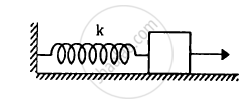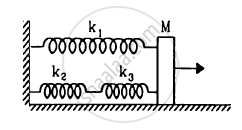Advertisements
Advertisements
प्रश्न
The equation of motion of a particle started at t = 0 is given by x = 5 sin (20t + π/3), where x is in centimetre and t in second. When does the particle
(a) first come to rest
(b) first have zero acceleration
(c) first have maximum speed?
उत्तर
Given:
The equation of motion of a particle executing S.H.M. is,
\[x = 5 \sin \left( 20t + \frac{\pi}{3} \right)\]
The general equation of S..H.M. is give by,
\[x = A \sin (\omega t + \phi)\]
(a) Maximum displacement from the mean position is equal to the amplitude of the particle.
As the velocity of the particle is zero at extreme position, it is at rest.
\[\therefore \text { Displacement }\] x = 5, which is also the amplitude of the particle.
\[\Rightarrow 5 = 5 \sin \left( 20t + \frac{\pi}{3} \right)\]
\[\text { Now }, \]
\[ \sin \left( 20t + \frac{\pi}{3} \right) = 1 = \sin\frac{\pi}{2}\]
\[ \Rightarrow 20t + \frac{\pi}{3} = \frac{\pi}{2}\]
\[ \Rightarrow t = \frac{\pi}{120} s\]
The particle will come to rest at \[\frac{\pi}{120} s\]
(b) Acceleration is given as,
a = ω2x
\[= \omega^2 \left[ 5 \sin \left( 20t + \frac{\pi}{3} \right) \right]\]
For a = 0,
\[5 \sin \left( 20t + \frac{\pi}{3} \right) = 0\]
\[ \Rightarrow \sin \left( 20t + \frac{\pi}{3} \right) = \sin \pi\]
\[ \Rightarrow 20t = \pi - \frac{\pi}{3} = \frac{2\pi}{3}\]
\[ \Rightarrow t = \frac{\pi}{30} s\]
\[\cos \left( 20t + \frac{\pi}{3} \right) = - 1 = \cos \pi\]
\[ \Rightarrow 20t = \pi - \frac{\pi}{3} = \frac{2\pi}{3}\]
\[ \Rightarrow t = \frac{\pi}{30} s\]
APPEARS IN
संबंधित प्रश्न
A particle executes simple harmonic motion with an amplitude of 10 cm. At what distance from the mean position are the kinetic and potential energies equal?
A particle having mass 10 g oscillates according to the equation x = (2.0 cm) sin [(100 s−1)t + π/6]. Find (a) the amplitude, the time period and the spring constant. (c) the position, the velocity and the acceleration at t = 0.
The pendulum of a clock is replaced by a spring-mass system with the spring having spring constant 0.1 N/m. What mass should be attached to the spring?
A block suspended from a vertical spring is in equilibrium. Show that the extension of the spring equals the length of an equivalent simple pendulum, i.e., a pendulum having frequency same as that of the block.
The spring shown in figure is unstretched when a man starts pulling on the cord. The mass of the block is M. If the man exerts a constant force F, find (a) the amplitude and the time period of the motion of the block, (b) the energy stored in the spring when the block passes through the equilibrium position and (c) the kinetic energy of the block at this position.

The springs shown in the figure are all unstretched in the beginning when a man starts pulling the block. The man exerts a constant force F on the block. Find the amplitude and the frequency of the motion of the block.

Solve the previous problem if the pulley has a moment of inertia I about its axis and the string does not slip over it.
A rectangle plate of sides a and b is suspended from a ceiling by two parallel string of length L each in Figure . The separation between the string is d. The plate is displaced slightly in its plane keeping the strings tight. Show that it will execute simple harmonic motion. Find the time period.

When the displacement of a particle executing simple harmonic motion is half its amplitude, the ratio of its kinetic energy to potential energy is ______.
Motion of an oscillating liquid column in a U-tube is ______.
Displacement versus time curve for a particle executing S.H.M. is shown in figure. Identify the points marked at which (i) velocity of the oscillator is zero, (ii) speed of the oscillator is maximum.

Draw a graph to show the variation of P.E., K.E. and total energy of a simple harmonic oscillator with displacement.
Find the displacement of a simple harmonic oscillator at which its P.E. is half of the maximum energy of the oscillator.
A mass of 2 kg is attached to the spring of spring constant 50 Nm–1. The block is pulled to a distance of 5 cm from its equilibrium position at x = 0 on a horizontal frictionless surface from rest at t = 0. Write the expression for its displacement at anytime t.
A particle undergoing simple harmonic motion has time dependent displacement given by x(t) = A sin`(pit)/90`. The ratio of kinetic to the potential energy of this particle at t = 210s will be ______.
The total energy of a particle, executing simple harmonic motion is ______.
where x is the displacement from the mean position, hence total energy is independent of x.
